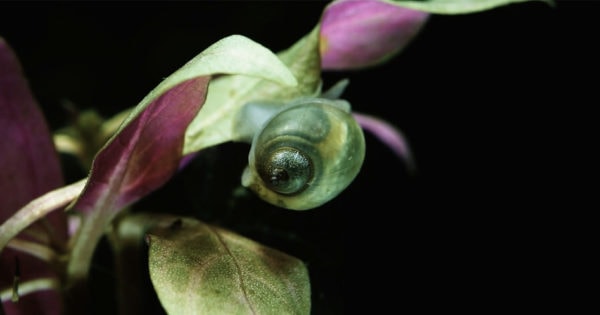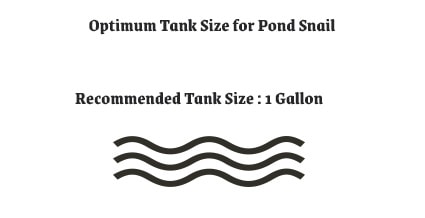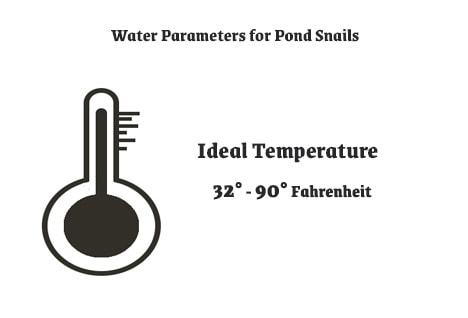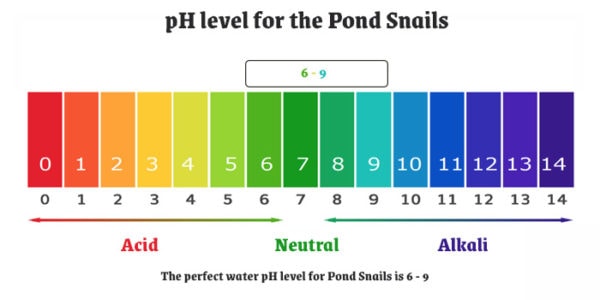Pond Snails, also known as ‘Great Pond Snails’, or even ‘Pest Snails’ as many aquarists say, are one of the biggest freshwater aquatic snail species. They live around the world, in Asia, Britain, and Canada, and even North Africa, they belong to the family of ‘Mud Snails’ or Lymnaeidae.
Pond Snails are one of the hardiest species there are. They can live and sometimes even thrive in an environment that might prove fatal to their other tankmates.
They have earned their reputation as ‘Pest Snails’. They often come in as invaders through aquatic plants, driftwood, stones, decoration items, etc.
Pond Snails are true survivors and very easy for any beginner to take care of. This makes them the most resilient creatures for first-timers.
| Information Chart | |
| Scientific Name: | Lymnaea stagnalis |
| Family: | Lymnaeidae |
| Care Level: | Very Easy |
| Temperament: | Peaceful, Solitary |
| Colour: | Brown |
| Lifespan: | Up to 3 years |
| Size: | Up to 3 inches |
| Diet: | Omnivorous |
| Minimum Tank Size: | 1 gallon |
| Temperature: | 32 to 90 degrees F |
| Water Conditions: | pH 6.5 to 8 |
| Tank Mate Compatibility | Peaceful community |
Table of Contents
Pond Snail Appearance

Pond Snails are brownish and have shells that are sharply tapered with a wide opening. The size and the shape of their shells differ based on their geographical positioning, as well as other factors such as their age and environment.
The color of their shells is brown, or dark yellow, with color variations such as light-brown to dark-brown. The wall of this shell appears almost translucent. There can be some marks or dents on their shells, which appear throughout their lifespan and are related to their diet and health.
There are no external shell markings, except the whorls on the shells which are around 2 to 6.
Pond Snails have thick, flattened tentacles which are shaped in a triangle.
To breathe from the air (aerial respiration), the snail must come up to the surface and open its breathing pore. They can also breathe directly through their skin (cutaneous respiration) inside the water.
Lastly, unlike other snail species, Pond Snails do not possess an operculum or a lid.
The lifespan of Pond Snail
The typical lifespan of a Pond Snail is 1.5 to 3 years. In the wild, the Pond Snails can live a little longer. They reach their sexual maturity at the age of 2.5 to 3.5 months.
Pond Snail Size
The typical Pond Snail typically grows up to 3 inches long. The size of the Pond Snails is very big, hence earning them the name ‘Great Pond Snails’. They can grow up to 1 to 3 inches long in the wild. In captivity, or even in freshwater, they only grow up to 2 inches. These snails have really large heads.
Natural Habitat and Origin
Pond Snails are natively freshwater creatures, originally belonging to the British Isles, specifically Britain and Ireland. They are now largely scattered across the world and are found more commonly in northern continents like northern Asia, Northern America, Canada, Tasmania, New Zealand, etc.
Pond Snails are found in lakes, ponds, and marshes as they prefer living in slow-moving waters or even stagnant water bodies. Even their scientific, Latin name Lymnaea stagnalis suggests that they like stagnant waters.
Pond Snail Care and Tank Set-up
Tank Size and Specifications

Optimum Tank Size for Pond Snail
The recommended tank size for Pond Snail is 1 gallon. Pond Snails do not need any strict tank sizes. They can survive in tanks as small as 1 gallon. They can even live inside a small bucket and do not have any other special requirements such as water filters, pumps, etc. A gallon tank should be more than enough for one Pond Snail to comfortably live in.
Tank Shape for Pond Snail
Pond Snails are resilient and the shape of the tank is not an important factor. However, they do co-exist with other tankmates in a peaceful community, so that tank does need to be able to accommodate them with the other snails or fishes.
Filter Type
Pond Snails do not need a filter per se, as they are very hardy and can live in any kind of water, though being freshwater creatures, they would prefer a similar water environment. Using a very simple sponge filter would be advisable. They also do not need anything like a heater or a pumper. However, in the absence of a filter, one would need to make constant water changes. Even though they are quite adaptive, they do need an environment conducive to staying alive.
Substrate
There are no specific substrate needs for Pond Snails. Their native environment is made up of marshy, swampy places. Even though they do not need their original environment to thrive, if an aquarist wishes to, they can create that using brown soil and peat.
How Many Pond Snails Can Live in a 1 Gallon Tank?
Up to 12 Pond Snails can live comfortably in a 1-gallon tank. However, if you wish to have more than that in your tank, the tank size would need to increase by at least one or two gallons with new additions. This is just to make sure that the Pond Snails have enough open space to explore and move around, to make for a good observing experience.
Water Parameters
Water Temperatures

The ideal water temperature for Pond Snails is 32 to 90 degrees Fahrenheit. As mentioned earlier, Pond Snails do not have stringent water requirements and can survive in almost any condition. They simply do not care enough as in the wild, they can easily live in lakes or waters that are semi-frozen.
Water Flow Rate
Pond Snails prefer stagnant water and so the ideal water flow rate should be very slow. However, they can also tolerate and live for quite some time in moving waters.
pH Level

The perfect water pH level for Pond Snails is between pH 6 to pH 9. Nevertheless, according to many studies, temporary changes in the water pH, up to even pH 3 or pH 3.5, can be tolerated by them. If the water pH level stays on the wider end of the spectrum for a longer time, then Pond Snails might experience problems, such as slowing down or disturbance in shell formation. This happens when low pH affects their calcium uptaking abilities.
Water Hardness
Pond Snails are survivors and will live in varying water hardness. The optimal degree of water hardness for Pond Snails must be between 4 to 8 dGH. They will be able to live in soft water for a short while as well.
Tank Landscape
Best Plants for Pond Snail Tanks
As the natural habitat for Pond Snails are slow-moving waters or stagnant water bodies with lots of plants, the tank for the Pond Snail can replicate that if you wish to, though it is not necessary, through artificial plants. Pond Snails also feed on plants, so choosing the right plants can not only prove to be a tank decoration but a source for food for the snail as well, especially having plants like algae. Having said that, Pond Snails are not plant safe. They will eat and up destroy the plants kept inside the tank. In the wild, their role in the ecosystem is to decompose and eat aquatic plants, acting as a sort of cleaning agent for the water. In the tank, their main role would be the same, almost like a cleanup crew. Hence, keeping live plants with the Pond Snails is a bad idea, as it may lead to overeating, which in turn will cause a snail outbreak in the tank.
Worst Plants for Pond Snail Tanks
Every plant is a bad plant for Pond Snails as they will tend to pick on them in the tank. They will not eat the plants voraciously but will poke holes in them or bite off bits from them. Pond Snails love eating the soft part of the plants over the midribs. It is best not to have any plants in the tanks that can be bitten or destroyed.
Decorations for Pond Snail Tanks
Given the small tank size requirements for the Pond Snails, tank decoration often becomes a secondary issue, and a very optional one. Pond Snails like to have dark places to hide in, so these can be provided by using rocks and artificial plants that can replicate dark, swampy vegetation. As these snails usually live with other species of fish in the tank, the tank decor can be tweaked to fit the needs of the other species, as Pond Snails do not care about it.
Lighting for Pond Snail Tanks
Pond Snails do not require any artificial source of light. Like most snails, they will be more than comfortable hiding in a dark corner of the tank.
Feeding Pond Snail
Best Diet for Pond Snail
Pond Snails tend to eat any decaying matter, whether it is an animal or a vegetable. Pond Snails primarily eat algae but they have also been known to eat floating aquatic plants or rooted plants in tanks or aquariums such as water lettuce (Pistia stratiotes), water hyacinth (Eichhornia crassipes), duckweed (Lemna minor), and Azolla (Azolla caroliniana). It is the algae on these aquatic plants that will first attract the attention of the Pond Snail and then it will carry on eating, as and when they feel like it, along with the plants themselves. Even the deep floating plants, which are partially submerged in ponds, include floating heart (Nymphoides peltatum) and water lilies (Nymphaea variations) are also eaten by these snails in the wild.
In captivity, as they are omnivores as well as scavengers, they tend to eat the debris, decaying plants, unfinished fish food, pellets, flake food, everything and anything that is given to them. Most of them suffer from calcium deficiencies, and the best way to avoid that is to give them a cuttlebone to make up for it.
How Often Should You Feed Pond Snail?
Pond Snails get a lot of food by themselves through the debris in the tank, but even then, one must be careful not to feed the pond snail a lot as it will cause a massive Pond Snail outbreak!
Pond Snail Behaviour and Temperament
Pond Snails are peaceful and can co-exist with a variety of other tankmates. They exhibit quite an interesting set of traits such as inhalation and exhalation of oxygen from the water through their lungs. This is also known as ‘large breathing’.
In case of an alarming or dangerous surrounding or stimulus, they retract themselves inside their shelf as a reflex action and sometimes even expel blood from their internal pores as a response to threatening external stimuli.
The Pond Snails can also be cannibalistic at times and eat fellow snails, leaving eating marks after the eating process. Since snails’ diet includes small animals often, they are often found in an attacking mode.
Are Pond Snails societal or lone?
Pond Snails often live peacefully with other bigger snails, as well as in fish tanks. They are good companions and can co-exist with a bunch of species. However, an aquarist should be wary of putting in Pond Snails with smaller snails as they might eat them, and even eat other small fishes.
Pond Snail Tank Mates
Ideal Pond Snail Tank Mates
The best tank mates for Pond Snails would be other larger fish and shrimp as they tend to eat small snails and fish. The ideal tank mates would be:
- Dwarf shrimp
- Other freshwater snails
Bad Tank Mates for Pond Snail
The bad tank mates for Pond Snails will be the fish or other snails that tend to prey on them. Large fish such as:
Smaller Ones Like:
- yo-yo loach
- skunk loach
- freshwater pufferfish
- dwarf puffer
Not only these fish, ‘assassin snails’ (Clea helena) who are snails themselves, will voraciously devour fellow snails and should be avoided in the tank which has Pond Snails.
Some other bad tank mates are:
Breeding Pond Snail
Pond Snails are hermaphrodite creatures that have a mixed mating system, where they can self and cross-fertilize. Adult Pond Snails can fertilize in both, male and female roles. They can reproduce both asexually and sexually, with the latter being their preferred method.
During the mating process, one of the snails acts as the male and the other as the female.
This is commonly decided on the criteria that the younger of the two usually acts as the male, whereas the older one decides to take on the role of the female. This could be because senior (and bigger) snails have more resources for reproduction as they produce more eggs. Another reason could be that the size of the prostate gland in younger snails increases faster.
However, this is not set in stone, as research shows that even snails who are barely an inch or older and bigger, are already able to mate through both ways — male and female.
When the snail mates in a male role, it climbs on the shell of the snail in a female role and moves over it in a counter-clockwise direction until the male reaches the female gonophore. This process can last for several hours.
The Pond Snails can give and receive sperm quite frequently, and the sperm that is received can be stored and used for around 3 months.
In the wild, once the females are ready, they lay egg masses, also known as oviposition, in cocoons. These masses contain around 50 to 100 eggs. inside these eggs, the embryos metamorphose on the 5th day or so, gradually forming an adult-like shape and shell.
Out of this mass, small snails looking like adults hatch after about 10 days.
In captivity, the process is fairly easy with minimum effort from the side of the aquarist. Once the eggs are laid, they can be moved out to another tank so they can hatch in peace, without the danger of being eaten by other snails or fish.
Pond Snail Breeding Level – Easy
Pond Snail Sexual Dimorphism?
Pond Snails are hermaphrodites, that is, having both male and female sex organs.
Pond Snail Common Diseases and their Treatment
Pond Snails are extremely hardy and they do not fall sick very often, or at all. They’re resilient to changes in water temperature, water flow, diet changes — almost everything.
They do need a proper calcium intake to develop their shells and sustain their bodies.
Calcium deficiencies
The biggest concern amongst Moon Crabs is having a calcium deficiency which can be avoided by giving them a calcium supplement such as a cuttlebone, and also sprinkling a little calcium powder in their food.
However, to breed and rear healthy Pond Snails, the basic requirements of tank hygiene, water changes, and temperature regulation have to be met.
Even though they do not cause any diseases for themselves, they can do so for their tankmates. Infection outbreaks can occur if the food leftovers from the tank can build up toxic compounds leading to problems such as Hydra, Green Fungus, Scutariella, etc.
Facts About Pond Snail
- They are the biggest aquatic freshwater snails.
- It can turn cannibalistic at times and eat its peer snails.
- They respond to any harmful stimulus by completely retracting inside their shell.
- The Pond Snails often move up to the surface to inhale air.
- Even their scientific, Latin name Lymnaea stagnalis suggests that they like stagnant waters.
Is A Pond Snail Right for You?
Author’s note: Pond Snails are usually not kept in aquariums by choice due to the multiple risk factors they possess to the tank environment as well as for the fear of damage they cause to plants, other fish, or snail species in the tank, earning them the name ‘Pest Snails’. However, they do have strong survival instincts, are remarkably hardy, and make up for a very easy and uncomplicated rearing experience for any beginner!
FAQs
Pond Snails are extremely hardy and they generally do not suffer from diseases. This makes them quite beginner-friendly.
Ideally, one can keep up to 12 Pond Snails together in a small tank of 1 gallon!
Generally, Pond Snails leave live plants alone, but they may tear them off, or try to eat them, so to be on the safe side, live plants are not recommended for Pond Snail tanks.
It is very hard to keep Pond Snails with Betta fish because of their aggressive fighting nature. Betta fish are territorial fish and do not tolerate tankmates (including snails and shrimp).
If the Pond Snails are kept in a community tank with fish or shrimp, there is no need to feed them. They will eat leftovers and clean the tank of any debris and sustain themselves through the leftover fish food. However, from time to time, one may need to feed them some calcium-rich food or give them a cuttlebone.
If the Pond Snail starts losing the color in its shell, that means that the water parameters are wrong and must be checked, as it can cause the shell to erode.
Conclusion
Pond snails are not dangerous, difficult, or a hassle to keep. In reality, they are one of the easiest snails to take care of. They are not fussy or require a special environment to grow in, they can grow in various surroundings and breed easily without any difficulties, however, Pond Snails are not welcomed in planted tanks as they depend on aquatic plants for their food. If you do decide to have Pond Snails as your pet, you don’t have much to worry about!
